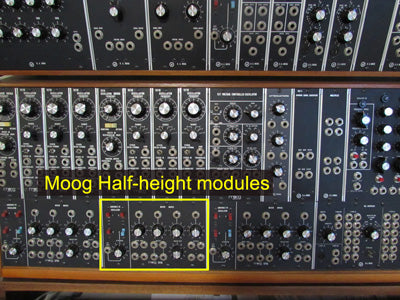In theory, modular synthesizers have independent modules for individual functions - oscillators, filters, envelopes. Modules can be moved, replaced, serviced. If we want extra oscillators, no problem. If we want sequencers on the bottom left or the top right, no problem. Modularity is a fantastic idea because it allows us to create our own instrument. It allows us to create different work flows and gives us the creative freedom to do our own thing unlike any other instrument.
Even though Moog systems are the most celebrated example of modularity in synthesizerdom, they fall short in one important way - half-height modules (actually, about 64% the height of a regular module). Moog systems have a single row of half-height modules along the bottom. These are mixers, utility modules and power switch panels. You've probably seen them but wasn't sure what to think. After all, it's a Moog, who's to question.
Since the late 60s when I first saw pictures of a Moog system, these dwarf modules haunted me. I hoped that one day I would understand some deeper meaning behind them but nope, they really are just half-height modules that can't be moved - they're stuck in the bottom row.
I wish I was there when this decision was made, maybe we'll never know the whole story, but it's a first-world tragedy. It was probably a combination of needing a place to put the power supply since full-size Moog modules consume most of the cabinet space, full-size modules bumping into the bottom of a tilted cabinet, expecting everyone would want/need mixers, and underestimating the value of full modularity that we cherish today.
Half-height modules place limits on users, and the core principle of modular synthesizers is No Limits!
Half-height modules violate the principle of modularity and limits the flexibility that makes modular synthesizers so amazing. A mixer should be able to go in any place in the system just like any other module, but half-height modules prevent that. Half-height modules makes systems more expensive, reduces functional density, and limits options - needlessly.
Half-height modules are one of the reasons I decided to build modernized modulars and not replicas of Moog modulars. I believe modularity should be taken to its logical conclusion, so in Synthesizers.com systems, all modules are full-height. This makes everything simpler, more logical, more free. You can move any module to any location in the cabinet, even the power modules. Modularity is one of the core principles in modular synthesizers and I believe full-height modules honors that in the truest way.
Synthesizers.com Studio-66. Full-height modules everywhere.


